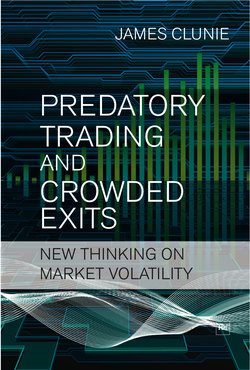Читать книгу Predatory Trading and Crowded Exits - James Clunie - Страница 18
На сайте Литреса книга снята с продажи.
The ecology of markets
ОглавлениеWhy build a model with only two or three types of actor? There is nothing to stop us from considering more realistic models, if these aid our understanding. We know that markets can contain index trackers, value investors, market makers, momentum traders, dynamic hedgers and many other participants. Together, these various parties make up the ecology of a market.
This way of thinking about markets is not yet dominant in the academic community, but has the support of a small number of influential thinkers. Perhaps it is the mathematical difficulty in modelling so many different types of agent that prevents its wider adoption.
Thinking about markets in ecological terms builds on work in sociobiology [1] and involves the application of evolutionary ideas to social interactions. Thinking about financial transactions in this way is an alternative to the use of equilibrium models. Ormerod (2005) argues that equilibrium models, much admired in economics literature, are unrealistic in light of the actual behaviour of markets. Bernstein (1998) argues that evolutionary processes better explain the workings of markets than does the notion of equilibrium.
In currency markets, for example, it is common for traders to talk about the ecology of markets. It is widely accepted that two major types of players are not motivated by profit and so can create opportunities for others to exploit. First among these are a number of central banks that intervene from time to time in the markets in an attempt to hold their own currencies at desired relative levels, in accordance with national economic or trade policy. Secondly, some international industrial firms hedge their foreign exchange exposures as a risk control measure, rather than as a profit-maximising measure. Arguably, the ecology of the currency markets is such that it provides opportunities for traders to earn profits at the expense of non-profit-motivated actors.
Sociobiological ideas can be seen in any research that involves studying the survival rates of certain types of traders. For example, Hirschleifer and Luo (2001) examine the long-term prospects of over-confident traders within a securities market – a study into the survival of a flawed species of market actor. Arguably, when economists discuss business cycles and the creative destruction of capitalism, they are expressing evolutionary thoughts about markets.
In his book, Education of a Speculator, Victor Niederhoffer (1997) writes about markets as a collection of different players. He thinks in terms of an ecology of markets and defines ecology as “the study of the webs that link the players [in the various markets]”. He argues that “slow-moving participants” such as the general public provide the losses or “energy source” upon which dealers, brokers and large hedge funds feed. He also explains how security prices can temporarily move away from their equilibrium values as a result of the activities of trend-followers who use stop losses to protect themselves from unlimited losses, and of dealers who hedge their options exposure.
Niederhoffer argues that the influence of prices in other markets and the behaviour of contrarian and value investors provides “homeostatic negative feedback” to any given market and helps to keep prices near to equilibrium value. His rich description of markets will be much more familiar to traders and investors than the simple asset pricing models that I discussed earlier. Of course, modelling such a complex eco-system can be difficult, and it is for this reason that many-asset pricing models consider only a small number of actors.
Some of the players in a market eco-system attempt to estimate the intrinsic value of securities. They place trades in an attempt to exploit apparent divergences from intrinsic value. A value investor would be the simplest example of such a player. By contrast, a momentum trader might follow trends in returns regardless of fundamentals, in the expectation that those trends will continue. Others players appear to have little interest in either value or momentum.
Consider, for example, a full replication index fund that must trade to match changes to a benchmark; or a retail investor who must sell securities at the prevailing market price to help finance a house purchase. Lo (2004) argues that:
because human behaviour is heuristic, adaptive, and not completely predictable – at least not nearly to the same extent as physical phenomena – modelling the joint behaviour of many individuals is far more challenging than modelling just one individual. Indeed, the behaviour of even a single individual can be baffling at times, as each of us has surely experienced on occasion.
Nevertheless, we should be able to achieve a better understanding of markets by studying how different players interact with one another. Agent-based modelling of markets [2] attempts to describe the developing behaviour and interaction of market participants, by defining the behaviour of agents and simulating outcomes amongst them. These models show that prices fluctuate with internal dynamics caused by the interaction of diverse trading strategies. They need not necessarily reflect true values.
